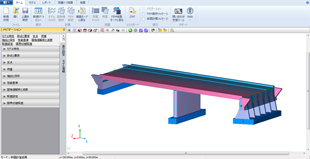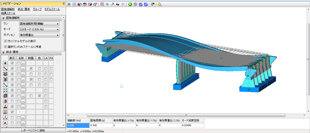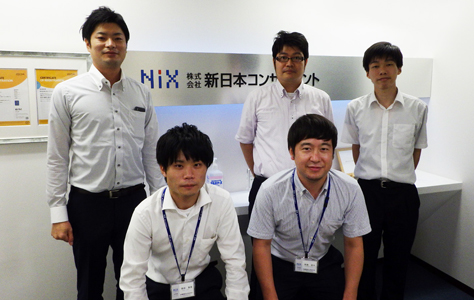Tasks of Structure and Bridge Group and Recent Tendency
The Company established its Tokyo Head Office 5 years ago, in 2015. 2 years later in 2017, Mr. Maruyama, Manager joined the Company.
"There had been no department for bridge design in Tokyo Head Office before I joined the company. It was established after that."
Currently, Tokyo Head Office has Tokyo Area Business Promotion Division and Tokyo Area Engineering Division. The latter is composed of Structure and Bridge Group and Waterworks Group. Structure and Bridge Group, which we interviewed for this report, is responsible for structure design in the roads/bridge business area. In specific, the Group is involved in a wide range of design work including 1) preliminary and detailed bridge design as its main job, 2) numeric analysis (two- and three-dimensional FEM), 3) temperature stress analysis of concrete, 4) construction planning and temporary structure design, 5) underground structure design, 6) large-scale waterway design, and 7) design of reinforced soil and retaining walls. Among them, Mr. Maruyama mainly takes on confirming the progress of entire work and the direction of how to proceed a project.
In this Group, in recent years, work related with reconstruction has been gradually increasing such as seismic reinforcement of bridges for Central Nippon Expressway (NEXCO Central) and improvement design of slab bridges. Through these projects, they have been able to get good performance evaluation. This is bringing about synergetic effects.
In a project of seismic reinforcement design of a viaduct that ranges 3km in length of the expressway, which they worked on recently as part of this, many diverse elements crossed over such as intersecting roads, sidewalks, railways, and use of space under the viaduct. Therefore, they have managed to perform the best reinforcement while lowering time and cost needed for work operation by properly grouping points with similar conditions to some degree for review.
Structure Design Work Expanded, Utilization of UC-1 Design Software Programs and ES Advanced
"I think introduction of UC-1 design software programs has something to do with work system reform in a sense."
That is, though they have to do manual calculation by using calculators and writing on paper as needed, dedicated design software makes it possible to increase efficiency greatly in total. Therefore, they have adopted positive approach of using these software programs for structural calculation etc. from before. To tell the truth, they found an occasion to start introducing various UC-1 design software programs in Tokyo Head Office largely because of trying to expand business related with structural design strategically, which was not so large in amount before, as Mr. Maruyama, Manager recalls. Such action is also interlocked with the recent years' tendency of securing human resources who are experienced with related areas like him.
"(The background of introducing) Engineer's Studio(R) is also similar."
However, according to him, in case of Engineer's Studio(R), it is impossible to replace it with manual calculation. It is hard to evaluate actual behavior without using such mechanical one like this. In particular, as earthquakes with high intensity have come to occur more often than before, taking large allowance into account by conventional calculation tends to result in excessive reinforcement. It was also aimed to make reinforcement in conformity with the reality more precisely. In addition, while the reinforcement method for structures with which seismic reinforcement is comparatively easy to execute has been almost established, most of the cases waiting for measures are those with complicated conditions. Partly because strict rendering of them requires review based on more complicated models, Engineer's Studio(R) has been used so often.
 |
 |
 |
| Nonlinear dynamic analysis of the existing bridge was performed using 3D solid models based on its characteristics |
As their specific cases, he mentions the following items he’s got involved with; 1) Performing dynamic nonlinear analysis of three-dimensional (3D) solid models based on characteristics of the bridge in applying seismic reinforcement for locking bridge piers with structure that depend its stability during earthquakes on the fixed part of abutment, and 2) Performing seismic inspection by dynamic nonlinear analysis over the 55-years old substructure of a water pipe bridge with ranger stiffening.
Paying attention to Potential of VR through Construction ICT Master Course
While using a series of software programs of FORUM8, 3 employees of the Company are currently taking "Course for Training Construction ICT Master" of FORUM8.
This course, which is meant to implement "Educational training program for utilizing VR contents aiming at fostering CIM engineers and promoting i-Construction" developed by FORUM8, has been adopted for "Educational training program development project", the Ministry of Health, Labour and Welfare-commissioned project for the fiscal years of 2019-2020. Mr. Maruyama, Manager mentions his motive for taking the course as that he wanted to know the prospect of the policies promoted by the Ministry of Land, Infrastructure, Transport and Tourism (MLIT) such as CIM and i-Construction as well as latest trends of advanced ICT (information and communication technology).
The course itself is still going on now, but through the course so far, he realized the potential of utilizing VR. For example, in reinforcing an existing bridge, if they say "Something in this kind of form will be attached to the bridge,", they can easily visualize communication like "How will the bridge look like when it is attached?", “Is the signal visible?” or "Isn't it better to move the signal as it will be hard to see it". Unlike the conventional two-dimensional paper drawings, those who are unfamiliar with design drawings can imagine the completed form. Therefore, great advantages can be expected not only for discussion with the client but also as a communication tool, for example, in explanation to the residents etc.
Further, he is drawing the picture of next step. Keeping introduction of FORUM8's 3D real-time VR "UC-win/Road" in mind, in planning rebuilding execution the whole bridge, he hopes to create something that can visualize how to arrange road alignment or what kind of a new bridge will be built, during the period from when the existing bridge is broken to the operation of the new bridge.
 |
|
| Staff of Structure and Bridge Group |
3 employees of the Company taking the Course
for Training Construction ICT Master |
|
